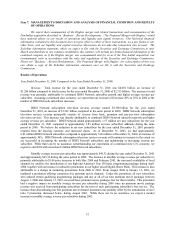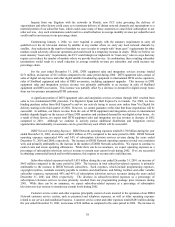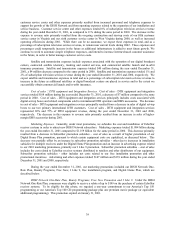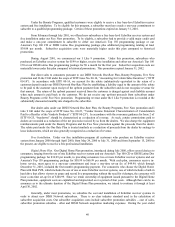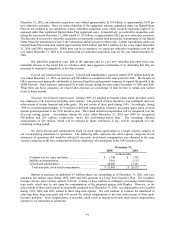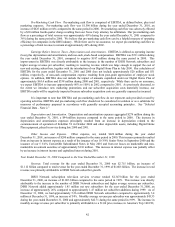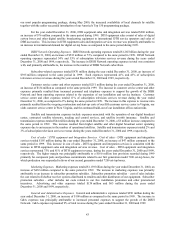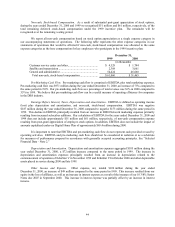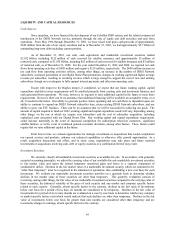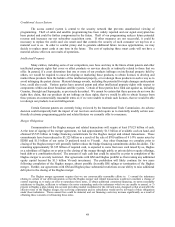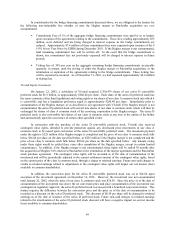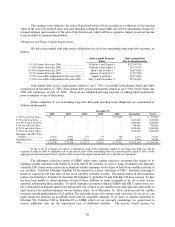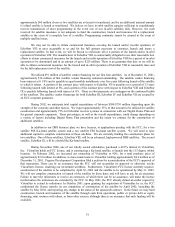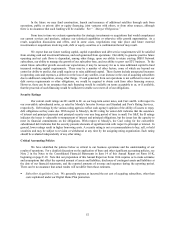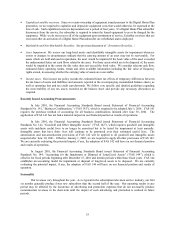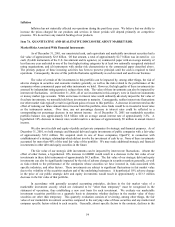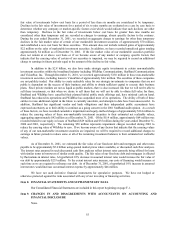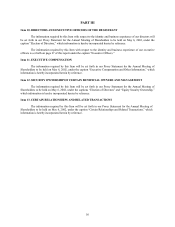Dish Network 2001 Annual Report Download - page 49
Download and view the complete annual report
Please find page 49 of the 2001 Dish Network annual report below. You can navigate through the pages in the report by either clicking on the pages listed below, or by using the keyword search tool below to find specific information within the annual report.47
Subscriber Turnover
Our percentage churn for the year ended December 31, 2001 increased compared to the same period during
2000. We believe that the increase resulted from the slowing economy, significant piracy of our competitor’s
products, stronger competition from digital cable and cable modems, bounty programs offered by competitors, our
maturing subscriber base, and other factors. While there can be no assurance, we currently expect that our
percentage churn during 2002 will be consistent with our percentage churn during 2001. We also expect that our
churn will continue to be lower than satellite and cable industry averages. In addition, impacts from our litigation
with the networks in Florida, new FCC rules governing the delivery of superstations and other factors could cause us to
terminate delivery of distant network channels and superstations to a material portion of our subscriber base, which
could cause many of those customers to cancel their subscription to our other services. Any such terminations could
result in a small reduction in average monthly revenue per subscriber and could result in an increase in our percentage
churn.
Commencing January 1, 2002, we were required to comply with the statutory requirement to carry all
qualified over the air television stations by satellite in any market where we carry any local network channels by
satellite. Any reduction in the number of markets we serve in order to comply with “must carry” requirements for other
markets would adversely affect our operations and could result in a temporary increase in churn. While we currently
believe we meet statutory “must carry” requirements, the FCC could interpret or implement its “must carry” rules in
ways that may require us to decrease the number of markets where we provide local channels. In combination, these
resulting subscriber terminations would result in a small reduction in average monthly revenue per subscriber and could
increase our percentage churn.
Subscriber Acquisition Costs
As previously described, we generally subsidize the cost and installation of EchoStar receiver systems in
order to attract new DISH Network subscribers. Our average subscriber acquisition costs were approximately $395
per new subscriber activation during the year ended December 31, 2001. Since we retain ownership of the
equipment, amounts capitalized under our Digital Home Plan, totaling approximately $338 million in 2001, are not
included in our calculation of these subscriber acquisition costs, which would be materially higher if we expensed
rather than capitalized Digital Home Plan equipment costs. While there can be no assurance, we currently expect our
per subscriber acquisition costs for the year ended December 31, 2002 to be consistent with per subscriber acquisition
costs for the year ended December 31, 2001. Our subscriber acquisition costs, both in the aggregate and on a per new
subscriber activation basis, may materially increase to the extent that we introduce other more aggressive
promotions if we determine that they are necessary to respond to competition, or for other reasons.
Funds necessary to meet subscriber acquisition costs will be satisfied from existing cash and investment
balances to the extent available. We may, however, be required to raise additional capital in the future to meet these
requirements. If we were required to raise capital today, a variety of debt and equity funding sources would likely
be available to us. However, there can be no assurance that additional financing will be available on acceptable
terms, or at all, if needed in the future.
Digital Home Plan
Our Digital Home Plan promotion, introduced during July 2000, offers several choices to consumers, ranging
from the use of one EchoStar receiver system and our America’s Top 100 CD or DISH Latino Dos programming
package for $36.99 per month, to providing consumers two or more EchoStar receiver systems and our America’s Top
150 programming package for $50.99 to $60.99 per month. With each plan, consumers receive in-home service, must
agree to a one-year commitment and incur a one-time set-up fee of $49.99, which through December 31, 2001,
included the first months programming payment. For consumers who choose the Digital Home Plan with Dish PVR,
which includes the use of one or more EchoStar receiver systems, one of which includes a built-in hard drive that
allows viewers to pause and record live programming without the need for videotape, the consumer will incur a one-
time set-up fee of $148.99. Our Digital Home Plan promotion requires us to capitalize and depreciate over four years
equipment costs that would otherwise be expensed at the time of sale, but also results in increased capital
expenditures. Capital expenditures under our Digital Home Plan promotion totaled approximately $338 million and
$65.4 million for the years ended December 31, 2001 and 2000, respectively.


